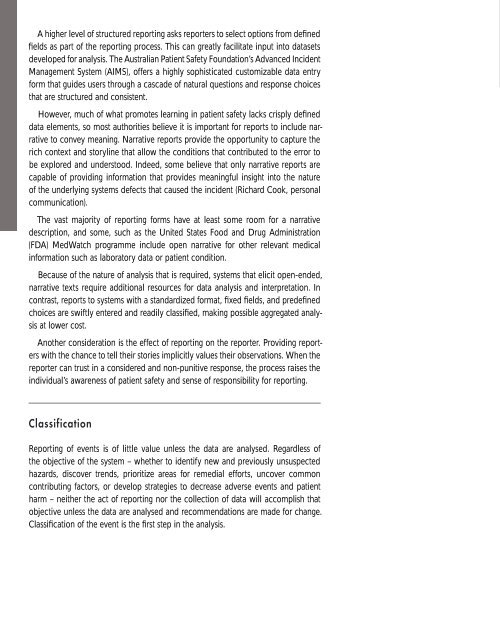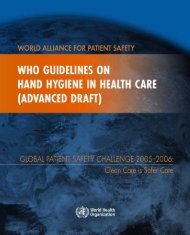Adverse event reporting.pdf
Adverse event reporting.pdf
Adverse event reporting.pdf
You also want an ePaper? Increase the reach of your titles
YUMPU automatically turns print PDFs into web optimized ePapers that Google loves.
A higher level of structured <strong>reporting</strong> asks reporters to select options from defined<br />
fields as part of the <strong>reporting</strong> process. This can greatly facilitate input into datasets<br />
developed for analysis. The Australian Patient Safety Foundation’s Advanced Incident<br />
Management System (AIMS), offers a highly sophisticated customizable data entry<br />
form that guides users through a cascade of natural questions and response choices<br />
that are structured and consistent.<br />
However, much of what promotes learning in patient safety lacks crisply defined<br />
data elements, so most authorities believe it is important for reports to include narrative<br />
to convey meaning. Narrative reports provide the opportunity to capture the<br />
rich context and storyline that allow the conditions that contributed to the error to<br />
be explored and understood. Indeed, some believe that only narrative reports are<br />
capable of providing information that provides meaningful insight into the nature<br />
of the underlying systems defects that caused the incident (Richard Cook, personal<br />
communication).<br />
The vast majority of <strong>reporting</strong> forms have at least some room for a narrative<br />
description, and some, such as the United States Food and Drug Administration<br />
(FDA) MedWatch programme include open narrative for other relevant medical<br />
information such as laboratory data or patient condition.<br />
Because of the nature of analysis that is required, systems that elicit open-ended,<br />
narrative texts require additional resources for data analysis and interpretation. In<br />
contrast, reports to systems with a standardized format, fixed fields, and predefined<br />
choices are swiftly entered and readily classified, making possible aggregated analysis<br />
at lower cost.<br />
Another consideration is the effect of <strong>reporting</strong> on the reporter. Providing reporters<br />
with the chance to tell their stories implicitly values their observations. When the<br />
reporter can trust in a considered and non-punitive response, the process raises the<br />
individual’s awareness of patient safety and sense of responsibility for <strong>reporting</strong>.<br />
Classification<br />
Reporting of <strong>event</strong>s is of little value unless the data are analysed. Regardless of<br />
the objective of the system – whether to identify new and previously unsuspected<br />
hazards, discover trends, prioritize areas for remedial efforts, uncover common<br />
contributing factors, or develop strategies to decrease adverse <strong>event</strong>s and patient<br />
harm – neither the act of <strong>reporting</strong> nor the collection of data will accomplish that<br />
objective unless the data are analysed and recommendations are made for change.<br />
Classification of the <strong>event</strong> is the first step in the analysis.
















